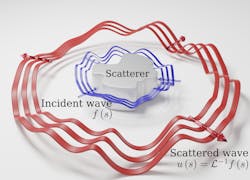Single nanoparticle can process optical signals for complex mathematical problems
After years of tailoring interactions between nanoscale materials and light waves, Andrea Alù, a professor of physics at The City University of New York (CUNY), and his team are now applying their findings to light-based analog computing.
“We’ve been working on metamaterials and metasurfaces that can apply mathematical operations and solve complex mathematical problems on input light signals,” says Alù. “The resulting operations are applied to the input signals at the speed of light—and with essentially no energy requirements.”
The researchers showed it’s possible to nanostructure a single particle made of silicon, with a size on the order of the wavelength of light, to process optical signals and even solve a complex mathematical problem like an integro-differential equation (see figure).
“This particle is interrogated by an incoming wave whose angular dependence encodes the input signal we want to process, and scattering from the particle encodes the solution of the complex mathematical problem at hand,” Alù explains. “By simply observing the scattering around the particle, we can read out the solution at the speed of light and with very low energy requirements.”
Alù’s team has been working on related topics, but until now had relied on large-area devices many wavelengths in size, which pose challenges for both implementation and integration within a more-complex optical system.
“We wondered if it’s possible to achieve a similar response with a compact nanostructure, encoding the input and output signals into the angular pattern of light waves exciting the nanostructure,” Alù says. “We found this is indeed possible, and our optimized geometries show very good performance metrics.”
Promising implications
Why is this so promising? “It offers a pathway for creating a new generation of very energy-efficient, ultrafast, ultracompact nanoscale optical computers and other nanophotonic technologies that can be used for classical and quantum computations,” says Heedong Goh, a postdoctoral researcher working with Alù.
The very small size of these nanoscale optical computers “is particularly appealing for scalability, because multiple nanostructures can be combined and connected together through light scattering to realize complex nanoscale computing networks,” adds Goh.
Alù finds the possibility of a single nanoparticle processing light for complex mathematical problems inspiring. Their discovery opens up a range of opportunities—including bringing nonlinearities into the picture, exploring even more-complex mathematical operations, and studying collections of these nanoparticles to potentially use nanophotonic systems leveraging these units as minicomputers.
So far this work is limited to theory and numerical simulations; the researchers are working on implementing these ideas in two platforms, one using photonic nanostructures through near-field optical microscopy, and one working with sound and 3D-printed geometries.
“I’m particularly intrigued by the prospect of demonstrating this operation experimentally, and including nonlinearities and collections of these elements to build complex computing systems,” says Alù.

Sally Cole Johnson | Editor in Chief
Sally Cole Johnson, Laser Focus World’s editor in chief, is a science and technology journalist who specializes in physics and semiconductors. She wrote for the American Institute of Physics for more than 15 years, complexity for the Santa Fe Institute, and theoretical physics and neuroscience for the Kavli Foundation.
